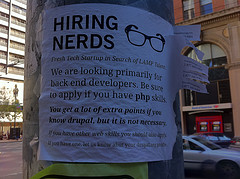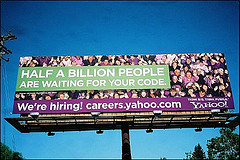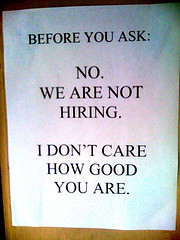|
|
|
Archive for November, 2011
Friday, November 4th, 2011
A Friday series exploring Startups and the people who make them go. Read all If the Shoe Fits posts here
 Yesterday I wrote abut new approaches to recruiting, a la online puzzles, to find tech talent from non-traditional sources, as well as advice from a successful entrepreneur who says that the most important traits to look for are behavioral and can only be identified through good interviewing, which requires time. Yesterday I wrote abut new approaches to recruiting, a la online puzzles, to find tech talent from non-traditional sources, as well as advice from a successful entrepreneur who says that the most important traits to look for are behavioral and can only be identified through good interviewing, which requires time.
All this says that younger entrepreneurs are willing to try radically new, as well as mastering old, approaches to finding talent.
The one thing I’ve found that many are not willing to do is hire outside their peers.
An old attitude that dates back decades (if not centuries) and which can be boiled down to five words—“people like me,” which defines your “comfort zone.”
It doesn’t matter that it’s illegal to say it involves age, but it does.
The bias is dangerous, especially when hiring more senior people as you grow. Consider these points,
- Can that brilliant developer you hired lead?
- Does the Twitter whiz kid understand creating and implementing a complete marketing strategy?
What exactly does a twenty-something a year or few out of school know about employment law, strategy, team-building, managing, conflict resolution, contract negotiation, the list goes on and on.
Whatever gave people the idea that creativity and innovation dropped off as experience increased?
One of these days in the not-too-distant future you are going to lose out on an opportunity because you are outside the company’s/manager’s comfort zone and the company is going to lose out on the richness of your experience.
How do you hire? What have you missed out on recently?
Option Sanity™ rewards performance.
Come visit Option Sanity for an easy-to-understand, simple-to-implement stock process. It’s so easy a CEO can do it.
Warning.
Do not attempt to use Option Sanity™ without a strong commitment to business planning, financial controls, honesty, ethics, and “doing the right thing.” Use only as directed.
Users of Option Sanity may experience sudden increases in team cohesion and worker satisfaction. In cases where team productivity, retention and company success is greater than typical, expect media interest and invitations as keynote speaker.
Image credit: kevinspencer
Posted in Entrepreneurs, Hiring, If the Shoe Fits | No Comments »
Thursday, November 3rd, 2011
 In 2007 Google developed an algorithm to improve their hiring. In a post citing that I wrote, “Google’s known for only hiring grads with a 3.7+ GPA, double 800 SAT scores and world-class interviewing skills—none of which are viable predictors of creativity or working success.” In 2007 Google developed an algorithm to improve their hiring. In a post citing that I wrote, “Google’s known for only hiring grads with a 3.7+ GPA, double 800 SAT scores and world-class interviewing skills—none of which are viable predictors of creativity or working success.”
Considering the story related by George Anders in his new book The Rare Find: Reinventing Recruiting it must not have worked.
These days the hot recruiting strategy for Google, Facebook and others are puzzles—at least for tech types, since the puzzles are focused on technical issues involving software and coding.
The great point about the puzzles is that they are open to anyone who wants to solve them, no matter their education or experience.
That’s right, no-name school or no school, iffy or rotten GPA; what’s important is how they think and how creative they are, but if you’re in the very early stages of hiring, even brilliant puzzle solving isn’t enough.
Your first hires are so critical, not just to traditional success, but because of the impact they have on determining the course of your culture, which can impact hiring forever.
Cezary Pietrzak, co-founder and director of business development at Wanderfly offers excellent insights on identifying your own gold-plated hires.
He assumes the candidates are “smart, talented, and, generally speaking, a rock star” and talks about the characteristics for which you should look.
Most of these are behavioral in nature; you’ll likely not find them on a resume, and traditional interview questions won’t uncover them, either. Yet their importance cannot be overstated, as often times they’re the difference between a great and poor working relationship.
Identifying these assets requires real work and a lot of it; ideally you’ll make interviewing a core competency for yourself and your entire company.
It requires committing time ungrudgingly, because you recognize the stratospheric ROI of good hiring.
After all, you are betting your company on those you hire.
Flickr image credit: {Guerrilla Futures | Jason Tester}
Posted in Entrepreneurs, Hiring, If the Shoe Fits | 1 Comment »
Wednesday, November 2nd, 2011
Posted in Wordless Wednesday | No Comments »
Tuesday, November 1st, 2011
 It’s always surprising how often different sources address the same problems offering similar solutions, but in such different ways that at first glance you wouldn’t notice. It’s always surprising how often different sources address the same problems offering similar solutions, but in such different ways that at first glance you wouldn’t notice.
Within days of each other, both Fortune/CNN and BNET offered up good information on employee motivation. Fortune/CNN article was science-based, while BNET was experience-based, with a leavening of humor.
They both said essentially the same thing with one exception, which I’ll get to in a minute.
Motivating employees means providing real purpose in their work; it requires challenging them and encouraging them to learn and grow; and it requires clear communications, including well-defined plans, roles and responsibilities.
Pretty standard stuff.
Now for the exception; the science offered up a new twist that just might help your implementation.
Removing obstacles is not the flip side of providing purpose, challenge and clear communications.
In other words, this is not one of those times that removing the negative means the positive will automatically rush in to fill the void or vice versa, that having the positives will overcome the negatives.
In this case you need to address the two as totally separate subjects.
First, remove any obvious negatives.
Next, start implementing the positives.
Third, be on the lookout for new obstacles.
Fourth, and most important, be sure that you on the side of the angels and not one of the obstacles.
Flickr image credit: zedbee
Posted in Ducks In A Row, Motivation, Personal Growth | No Comments »
|
 Subscribe to
Subscribe to
MAPping Company Success
About Miki 
Clarify your exec summary, website, etc.
Have a quick question or just want to chat? Feel free to write or call me at 360.335.8054
The 12 Ingredients of a Fillable Req
CheatSheet for InterviewERS
CheatSheet for InterviewEEs™
Give your mind a rest. Here are 4 quick ways to get rid of kinks, break a logjam or juice your creativity!
Creative mousing
Bubblewrap!
Animal innovation
Brain teaser
The latest disaster is here at home; donate to the East Coast recovery efforts now!
Text REDCROSS to 90999 to make a $10 donation or call 00.733.2767. $10 really really does make a difference and you'll never miss it.
And always donate what you can whenever you can
The following accept cash and in-kind donations: Doctors Without Borders, UNICEF, Red Cross, World Food Program, Save the Children
*/
?>About Miki
About KG
Clarify your exec summary, website, marketing collateral, etc.
Have a question or just want to chat @ no cost? Feel free to write
Download useful assistance now.
Entrepreneurs face difficulties that are hard for most people to imagine, let alone understand. You can find anonymous help and connections that do understand at 7 cups of tea.
Crises never end.
$10 really does make a difference and you’ll never miss it,
while $10 a month has exponential power.
Always donate what you can whenever you can.
The following accept cash and in-kind donations:
|
 Yesterday I wrote abut new approaches to recruiting, a la online puzzles, to find tech talent from non-traditional sources, as well as advice from a successful entrepreneur who says that the most important traits to look for are behavioral and can only be identified through good interviewing, which requires time.
Yesterday I wrote abut new approaches to recruiting, a la online puzzles, to find tech talent from non-traditional sources, as well as advice from a successful entrepreneur who says that the most important traits to look for are behavioral and can only be identified through good interviewing, which requires time.



 In 2007 Google developed an algorithm to improve their hiring. In a post citing that
In 2007 Google developed an algorithm to improve their hiring. In a post citing that 


 It’s always surprising how often different sources address the same problems offering similar solutions, but in such different ways that at first glance you wouldn’t notice.
It’s always surprising how often different sources address the same problems offering similar solutions, but in such different ways that at first glance you wouldn’t notice.
